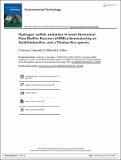| dc.contributor.author | Gerrity, Seán | |
| dc.contributor.author | Kennelly, Colm | |
| dc.contributor.author | Clifford, Eoghan | |
| dc.contributor.author | Collins, Gavin | |
| dc.date.accessioned | 2019-03-26T14:27:48Z | |
| dc.date.available | 2019-03-26T14:27:48Z | |
| dc.date.issued | 2016-03-17 | |
| dc.identifier.citation | Gerrity, S., Kennelly, C., Clifford, E., & Collins, G. (2016). Hydrogen sulfide oxidation in novel Horizontal-Flow Biofilm Reactors dominated by an Acidithiobacillus and a Thiobacillus species. Environmental Technology, 37(17), 2252-2264. doi: 10.1080/09593330.2016.1147609 | en_IE |
| dc.identifier.issn | 1479-487X | |
| dc.identifier.uri | http://hdl.handle.net/10379/15055 | |
| dc.description.abstract | Hydrogen Sulfide (H2S) is an odourous, highly toxic gas commonly encountered in various commercial and municipal sectors. Three novel, laboratory-scale, Horizontal-Flow Biofilm Reactors (HFBRs) were tested for the removal of H2S gas from air streams over a 178-day trial at 10 degrees C. Removal rates of up to 15.1 g [H2S] m(-3) h(-1) were achieved, demonstrating the HFBRs as a feasible technology for the treatment of H2S-contaminated airstreams at low temperatures. Bio-oxidation of H2S in the reactors led to the production of H+ and sulfate (SO42-) ions, resulting in the acidification of the liquid phase. Reduced removal efficiency was observed at loading rates of 15.1 g [H2S] m(-3) h(-1). NaHCO3 addition to the liquid nutrient feed (synthetic wastewater (SWW)) resulted in improved H2S removal. Bacterial diversity, which was investigated by sequencing and fingerprinting 16S rRNA genes, was low, likely due to the harsh conditions prevailing in the systems. The HFBRs were dominated by two species from the genus Acidithiobacillus and Thiobacillus. Nonetheless, there were significant differences in microbial community structure between distinct HFBR zones due to the influence of alkalinity, pH and SO4 concentrations. Despite the low temperature, this study indicates HFBRs have an excellent potential to biologically treat H2S-contaminated airstreams. | en_IE |
| dc.description.sponsorship | This work was supported by Science Foundation Ireland [grant number 08/RFP/ENM1762] and a European Research Council Starting Grant (3C-BIOTECH; no. 261330). | en_IE |
| dc.format | application/pdf | en_IE |
| dc.language.iso | en | en_IE |
| dc.publisher | Taylor & Francis | en_IE |
| dc.relation.ispartof | Environmental Technology | en |
| dc.rights | Attribution-NonCommercial-NoDerivs 3.0 Ireland | |
| dc.rights.uri | https://creativecommons.org/licenses/by-nc-nd/3.0/ie/ | |
| dc.subject | H2S oxidation | en_IE |
| dc.subject | gas treatment | en_IE |
| dc.subject | Horizontal-Flow Biofilm Reactor | en_IE |
| dc.subject | Acidithiobacillus | en_IE |
| dc.subject | Thiobacillus | en_IE |
| dc.subject | POLYMERASE-CHAIN-REACTION | en_IE |
| dc.subject | BIOTRICKLING FILTER | en_IE |
| dc.subject | BIOLOGICAL OXIDATION | en_IE |
| dc.subject | LOW-TEMPERATURES | en_IE |
| dc.subject | ACTIVATED CARBON | en_IE |
| dc.subject | PACKING MATERIAL | en_IE |
| dc.subject | HFBR TECHNOLOGY | en_IE |
| dc.subject | RIBOSOMAL-RNA | en_IE |
| dc.subject | H2S EMISSION | en_IE |
| dc.subject | WASTE-WATER | en_IE |
| dc.title | Hydrogen sulfide oxidation in novel Horizontal-Flow Biofilm Reactors dominated by an Acidithiobacillus and a Thiobacillus species | en_IE |
| dc.type | Article | en_IE |
| dc.date.updated | 2019-03-22T16:15:57Z | |
| dc.identifier.doi | 10.1080/09593330.2016.1147609 | |
| dc.local.publishedsource | https://doi.org/10.1080/09593330.2016.1147609 | en_IE |
| dc.description.peer-reviewed | peer-reviewed | |
| dc.contributor.funder | Science Foundation Ireland | en_IE |
| dc.contributor.funder | European Research Council | en_IE |
| dc.internal.rssid | 11342651 | |
| dc.local.contact | Eoghan Clifford, Room 1035, Alice Perry Engineering Building, Nui Galway, Galway. 2219 Email: eoghan.clifford@nuigalway.ie | |
| dc.local.copyrightchecked | Yes | |
| dc.local.version | ACCEPTED | |
| dcterms.project | info:eu-repo/grantAgreement/SFI/SFI Research Frontiers Programme (RFP)/08/RFP/ENM1762/IE/Optimisation of a novel biofilm technology for the removal of nuisance odours using microsensors molecular biology techniques and mathematical modelling/ | en_IE |
| dcterms.project | info:eu-repo/grantAgreement/EC/FP7::SP2::ERC/261330/EU/Cold Carbon Catabolism of Microbial Communities underprinning a Sustainable Bioenergy and Biorefinery Economy/3CBIOTECH | en_IE |
| nui.item.downloads | 342 | |


